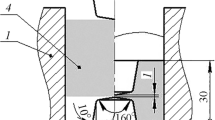Abstract
Hot radial forging is used to reduce porosity and increase strength for large-diameter billets. The goal of this research is to study void closure behavior in the hot radial forging process. A nonlinear coupled finite element model is developed to investigate the deformation mechanism of internal void defects during the hot radial forging process. The model is formulated in a three-dimensional frame and a viscoplastic material model has been used to describe the material behavior subjected to large deformation and high temperature. A global–local technique is employed to obtain accurate solutions around the void region. The effects of void location, mandrel, die shape, and the reduction of the tube thickness on the final void reduction are systematically investigated. The predicted reductions for central longitudinal voids in hot upsetting and hot rolling processes are in good agreement with experimental findings. The simulation results provide a valuable procedure for the design of porosity reduction during the hot radial forging process.
Similar content being viewed by others
References
Domblesky JP, Shivpuri R, Painter B (1995) Application of the finite-element method to the radial forging of large diameter tubes. J Mater Proces Tech 49:57–74
Altan T, Oh SI, Gegel H (1983) Metal forming fundamentals and applications. American Society for Metals, Materials Park
Yano H, Akshi T (1994) Application of analytical simulation to forged part design. Toyota Tech Rev 43(2):22–27
Altan T, Knoerr M (1992) Application of the 2D finite element method to simulation of cold-forging process. J Mater Process Technol 35:275–302
Jang DY, Liou JH (1998) Study of stress development in axisymmetric products processed by radial forging using a 3-D nonlinear finite element method. J Mater Process Technol 74:74–88
Ghaei A, Movahhedy MR (2007) Die design for the radial forging process using 3D FEM. J Mater Process Technol 182:534–539
Chen J, Chandrashekhara K, Richards VL, Lekakh SN (2010) Three-dimensional nonlinear finite element analysis of hot radial forging process for large diameter tubes. Mater Manuf Process 25:669–678
Wallero A (1985) Closing of a central longitudinal pore in hot rolling. J Mech Work Technol 12:233–242
Kopp R, Ambaum E (1978) Behavior of internal hollows in forging during open-die forging. Stahl and Eigen 96:1004–1009
Dudra SP, Im YT (1990) Analysis of void closure in open-die forging. Int J Mach Tool Manuf 30:65–75
Hwang Y, Chen D (2002) Finite element simulations on void closure behavior inside the sheet during sheet rolling process. Proc Ins Mech Eng 216:1227–1237
Chen D (2006) Rigid-plastic finite element analysis of plastic deformation of porous metal sheet containing internal void defects. J Mater Process Technol 180:193–200
Lee YS, Kwon YC, Kwon YN, Lee JH, Lee SW, Kim NS (2007) Analysis on void closure behavior during hot open die forging. Adv Mater Res 26–28:69–72
Lee M, Jang S, Cho J, Joun M (2008) Finite element simulation of pore closing during cylinder upsetting. Int J Modern Phys B 22:5768–5773
Kim S, Lee M, Jang S, Eom J, Joun M (2010) Comparative study on pore closing in open die forging by conventional forging press and radial forging machine. Trans Mater Process 19:399–404
Zhang X, Cui Z (2009) Theoretical study of void closure in nonlinear plastic materials. Appl Math Mech 30:631–642
Zhang X, Cui Z, Chen W, Li Y (2009) A criterion for void closure in large ingots during hot forging. J Mater Process Technol 209:950–959
Tszeng, TC (1987) Residual stress calculation by finite element method in manufacturing. Ph.D. thesis. Department of Mechanical Engineering, University of California, Berkley, CA
Ameli A, Movahhedy MR (2007) A parametric study on residual stresses and forging load in cold radial forging process. Int J Adv Manuf Tech 33:7–17
Nagpal V, Lahoti GD (1980) Application of the radial forging process to cold and warm forging of cannon tubes. In: Selection of die and mandrel materials, vol II. Battelle Columbus Laboratories, Columbus, pp 62–63
Shida S (1969) Empirical formula of flow stress of carbon steels—resistance to deformation of carbon steels at elevated temperature. J Jpn Soc Technol Plast 10:610–617
Lee Y, Kim BM, Park KJ (2002) A study for the constitutive equation of carbon steel subjected to large strains, high temperatures and high strain rates. J Mater Process Technol 130–131:181–188
Tang J (2006) A study of oxide scale deformation and surface roughness transformation in hot strip rolling. Ph.D. Thesis, School of Mechanical, Materials and Mechatronic Engineering, University of Wollongong, Wallongong, Australia
Fries R (1971) The elevated temperature properties of two 81 mm mortar tube alloys 4337 M and 4140. Technical report WVT-7106, Benet R&E Laboratories
Author information
Authors and Affiliations
Corresponding author
Rights and permissions
About this article
Cite this article
Chen, J., Chandrashekhara, K., Mahimkar, C. et al. Study of void closure in hot radial forging process using 3D nonlinear finite element analysis. Int J Adv Manuf Technol 62, 1001–1011 (2012). https://doi.org/10.1007/s00170-011-3876-3
Received:
Accepted:
Published:
Issue Date:
DOI: https://doi.org/10.1007/s00170-011-3876-3




